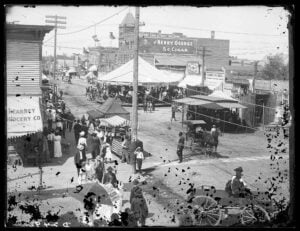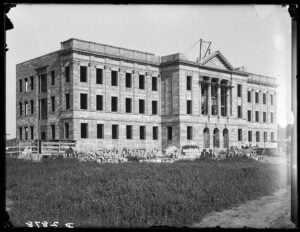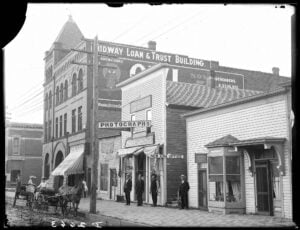
Solomon Butcher is the most famous photographer to live and work in Kearney, known nationally for his images of homesteaders and early settlement in and around Custer County, Nebraska. Nearly all of Butcher’s renown is posthumous. The sole biographer of Butcher, John Carter, found that “It is curious that S.D. Butcher has crept, almost anonymously, into the fundamental fabric of American thinking about the West.1” Over the last century his images appeared frequently in histories and documentaries about the American West. From 1902 until 1915 he lived in Kearney and maintained a series of downtown studios. Butcher is defined by his sod house photos, but they make up a small portion of some 4,000 prints and negatives he created over his long career.2 Hundreds document the comings and goings of Kearney in the early twentieth century.
Carter found him “funny, eccentric, and just a little out of step with the rest of the world. “He was also an important photographer.3” Born in 1856 in what became West Virginia within a decade, Butcher grew up in Illinois. In 1880 the Butchers moved to Custer County, Nebraska to homestead. Butcher was not cut out for homesteading and left for Minneapolis to briefly attended medical school. His schooling was short. After a year he left and returned to Nebraska, married, and established the first photography studio in the Custer County.4
To drum-up business, Butcher undertook a documentary project that now largely defines his career: a history of Custer County built around photographs of and interviews with homesteaders. Locals purchased copies by subscription and when “Pioneer History of Custer County and Short Sketches of Early Days in Nebraska” appeared in 1901 it sold out and a second edition was published.5
Following the local success of the Pioneer History, the Butcher family moved to Kearney. Solomon and his son, Lynn, opened a studio in town, and planned similar photographic histories of Buffalo and Dawson counties.6 Butcher was not Kearney’s only photographer in the early 20th century. A. T. Anderson and John Stryker operated successful studios in the city. The three major studios and some smaller enterprises competed for local business. Butcher captured important images of Kearney’s growth during his time in town.
Yet, this stiff competition forced him to go further afield for photographic opportunities. He traveled the region, including Wyoming, Colorado, and Utah, and later Texas, documenting small towns, rodeos, and natural scenery. According to Carter, Butcher made negatives on the road and shipped them to Kearney where his son and staff finished the images. Postcards were a core of the Butcher’s business and Carter estimates they made two and a half million of them in Kearney.7
While in Kearney and after drawn out debates about payment in the State Legislature, Butcher sold his negatives to the Nebraska State Historical Society-now History Nebraska. After the sale he left Kearney and moved to Broken Bow in 1915. In 1926 he moved to Greeley, Colorado to live near his daughter and died the following year.8 Butcher was buried in Broken Bow.





